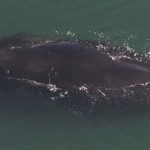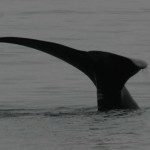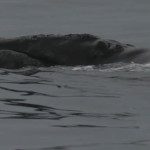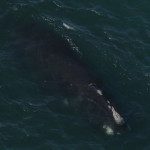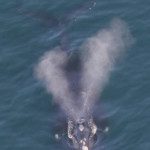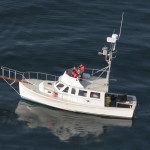February 2008
One of the ways to distinguish a right whale from other large whales is their characteristic v-shaped blow, as seen in this image from our flight on Friday.
25 February. A second consecutive day of good weather provided an opportunity to survey east of Cape Cod in search of right whales. While in transit through Cape Cod Bay, just a few minutes into our survey, we came across a single right whale. Although this animal was diving for intervals close to fifteen minutes, we were able to get several good photographs during its short time at the surface. We continued northward and began our offshore survey. After investigating a spout which turned out to be from a fin whale, we finally saw a great deal of splashing and a black, paddle-like flipper sticking out of the water – telltale signs of a right whale “surface active group†or SAG! Right whales frequently form SAGs, which are short-term aggregations near the surface of the water in which a great deal of physical contact takes place among the animals. The SAG that we found today included six different right whales, but in the past, scientists have documented SAGs which have included over forty whales!
24 February. We began our survey by transiting up the back side of Cape Cod, where we saw three fin whales off the coast of Truro. It is not uncommon to see these large baleen whales in this area, as the steep drop-off from land causes nutrients to be pushed up towards the sunlight creating ideal conditions for the production of food. All of Cape Cod Bay was surveyed in good weather conditions, but no right whales were seen.
22 February. The R/V Shearwater chugged out, earlier then usual, into Cape Cod Bay amidst steady snowfall and a moderate wind. The PCCS habitat studies team was excited and anxious to collect samples, as it had been about two weeks since the last cruise due to long periods of high winds. Little gear, vessels, and marine mammals were sighted, probably due to poor visibility and conditions. Six of the eight regular stations were sampled, both with plankton tow nets for zooplankton resource evaluation, and with a niskin bottle and CTD for nutrients and physical characteristics. The zooplankton resource was dominated by pseudocalanus species and appeared to have increased in density since the last cruise; in fact it had surpassed the density threshold of what is attractive to feeding right whales. As the day wore on, conditions worsened; the snow and winds were picking up. Sightings included one confirmed right whale, as well as an unidentified breaching whale far in the distance; a breach is a behavioral display during which a whale will propel itself straight out of the water, and then fall back in, usually on its side or back. The R/V Shearwater returned to port, dowsed with salty spray and ice. We look forward to fairer skies, and the growing zooplankton resource which may indicate that right whales are on their way to Cape Cod Bay.
February 21. After two and half weeks of high winds, the aerial survey team took off from Chatham anxious to see what’s happening in Cape Cod Bay. Unfortunately, the winds had not subsided as quickly as we had hoped, and there were still quite a few whitecaps obscuring our view. We were fortunate to find one right whale amidst the rough seas and get some photos of the callosity pattern before calling it a day and returning to the airport. We later determined that the whale was EGNO 1503, an adult female last seen in Massachusetts Bay in 2006. She gave birth to a calf two years ago.
04 February. The habitat studies team set out for their fourth cruise of the season. The sea and weather conditions were moderate with a northerly swell, 2-foot seas and an overcast sky. Over the course of the day, the habitat team sighted two right whales, both of which were also observed and identified the previous day by the PCCS aerial survey team. Right whales have several characteristics that make them easily identifiable, such as their v-shaped spout, callosities, black fluke and low profile. Although right whales were spotted multiple times, insufficient zooplankton resources indicate that that these animals are not likely to take up residency in the Bay, or aggregate in the near future. At all 8 sampling stations, pseudocalanus was the dominant zooplankton genus collected. The highest zooplankton concentration observed, and the only sample that was dense enough to trigger right whale feeding, was collected at the surface of one of our regular stations, very close to the second right whale found. This whale was not feeding at the surface, but was going on deep fluking dives. Such dives may be indicative of bottom feeding. To better understand the distribution of zooplankton in the bay, samples collected with a directed discrete depth vertical pump will be taken on forthcoming cruises. The team completed their cruise by sunset, anxious to compare their whale sightings with those of the aerial survey team.
February 03. The aerial survey team completed a full survey of Cape Cod Bay in beautiful sighting conditions again on Sunday. The beginning of the survey was uneventful, with no whale sightings as we traveled up the back side of the Cape and around into the northern half of Cape Cod Bay. About halfway through the flight, we spotted the distinctive callosity of a right whale very close to shore near Truro/Wellfleet. After circling to photograph the right whale and collect behavioral data, we returned to our tracklines and continued working our way south. We were just about ready to head in for the day when a second right whale was spotted on our last trackline, again in shallow water, this time just north of Barnstable Harbor. The whale was resting motionless at the surface of the water in a behavior known as “loggingâ€, so it was quite easy to get the photographs necessary to match the whale to the catalog of known individuals. Anxious to get a closer look at our data and photos, we returned to the Chatham airport.

Our Work
Humpback Whale Research
Right Whale Research
Marine Animal Entanglement Response
Marine Geology Department
Water Quality Monitoring Program
Marine Fisheries Research
Seal Research
Shark Research
Marine Education
Interdisciplinary
Marine Debris and Plastics Program
Marine Policy Initiative
Cape Cod Climate Change Collaborative
Publications

